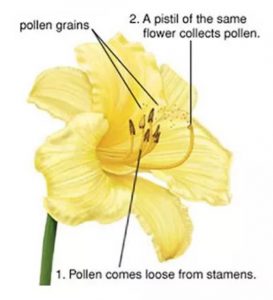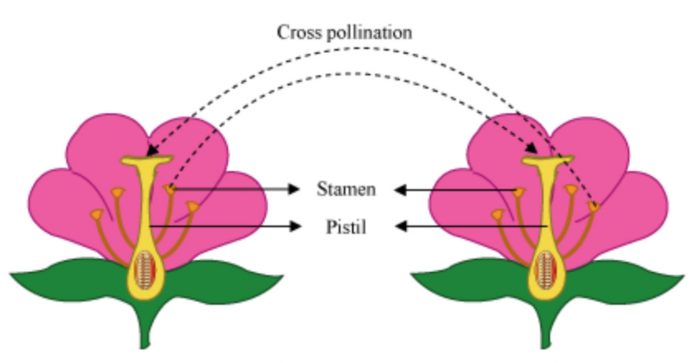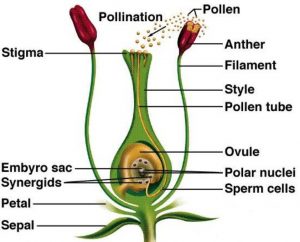Question 1 Define the term self pollination and cross pollination?
Question 2 Name three agents which can carry out pollination?
Question 3 What is pollination? How does pollination occur?
Question 4 How do insects help in pollination?
Question 5 how do wind help in pollination?
Question 6 How do water help in pollination?
Question 7 What is meant by fertilisation?
Question 8 How does the process of fertilisation take place in flowers?
Question 9 Define the term germination?
Question 10 Explain how formation of fruits and seeds take place?
Contents
Pollination
The transfer of pollen grains from the anther of a stamen to the stigma of a pistil is called pollination.
Pollination can occur in two ways: self-pollination and cross-pollination.
Self Pollination
(1) When the pollen grains from the anther of a flower are transferred to the stigma of the same flower (or another flower on the same plant), it is called self-pollination.
Cross Pollination
(2) When the pollen grains from the anther of a flower on one plant are transferred to the stigma of a flower on another similar plant, it is called cross-pollination.
Pollination is done by insects, wind and water.
(1) Pollination by Insects
Pollination is done by insects such as bees and butterflies. The insects carry pollen from flower to flower and help in pollination. Certain flowers have nectary near their base which contains a sugary liquid called nectar. When an insect sits on the flower of a plant for sucking nectar, then the pollen grains from the anther of this flower stick to its body. And when this insect now sits on another flower to suck nectar, then the pollen grains sticking to its body are transferred to the stigma of this second flower.
The insect pollinated flowers have large, bright coloured, and scented petals as well as nectar to attract insects for pollination. They have large pollen grains which can stick to the body of insects. The insect pollinated flowers have anthers and stigmas inside the flower so that the insect can brush against them when it is drinking nectar.
The insect pollinated flowers are of the plants such as : sunflower, marigold, Bougainvillea, jasmine, banana, and banyan, etc.
(2) Pollination by Wind
The blowing wind carries pollen grains from one flower to other flowers and helps in pollination. The wind pollinated flowers have anthers that hang outside the flowers to catch the wind. They produce large amount of light, small pollen grains which can blow in the wind. The wind-pollinated flowers have also spreading and feathery stigmas to catch the air-borne pollen grains.
Some of the wind-pollinated flowers are in the plants such as grass, maize, rice, sugarcane, bamboo and palms.
(3) Pollination by Water
The pollination in aquatic plants (particularly those plants which are submerged in water) is done by water. Since pollen grains are light, they are easily carried by water from flower to flower for pollination. The pollination in aquatic plants such as Vallisneria and Hydrilla is carried out by water.
Fertilisation
The process in which the male gamete present in pollen grain fuses (joins) with the female gamete present in ovule to form a new cell called zygote is called fertilisation.
When a pollen grain falls on the stigma of the pistil, the pollen grain grows a pollen tube downwards through the style towards the female gamete in the ovary. A male gamete moves down the pollen tube. The pollen tube enters the ovule in the ovary. The tip of pollen tube bursts open and male gamete comes out of pollen tube. In ovary, the male gamete of pollen combines (or fuses) with the female gamete present in ovule to form a fertilised egg cell called zygote. Zygote develops into an embryo. Embryo is that part of a seed which develops into a new plant. An embryo is a kind of baby plant in dormant state.
Formation of Fruits and Seeds
After fertilisation, the ovule present in ovary grows to become a seed. The seed contains embryo (baby plant) and food for developing new plant. There is a tough protective coating around the seed which is called seed coat. All the ovules present in the ovary of a flower get fertilised by pollen grains and grow to become seeds. Thus, the ovary of a flower may give rise to a number of seeds.
After fertilisation, the ovary of a flower develops and becomes a fruit (with seeds inside it). Fruit is the ripened ovary of a flower. So, at the place on the plant where we had a flower originally, we now have a fruit (which is the ovary of the flower containing seeds). A fruit protects the seeds.
Apples, oranges, mangoes, plums, lemons, tomatoes, pea pods, almonds, peanuts, and walnuts, are all fruits. They all have seeds inside them.
Germination
The process in which a seed begins to grow is called germination. When a seed germinates, the seed coat splits, a tiny root grows downward and a shoot grows upwards. This produces a seedling of the plant. The seedling grows further and ultimately forms a new plant. After a certain period, the plant bears flowers. These flowers again produce fruits and seeds.
Wheat grains, gram (chana), maize (makka), peas and beans, etc. are all seeds.



Thanks a lot…..its easy biology for everyone…..summerised and strait to the point
Thank you so much it is so helped for my test..all d best ..